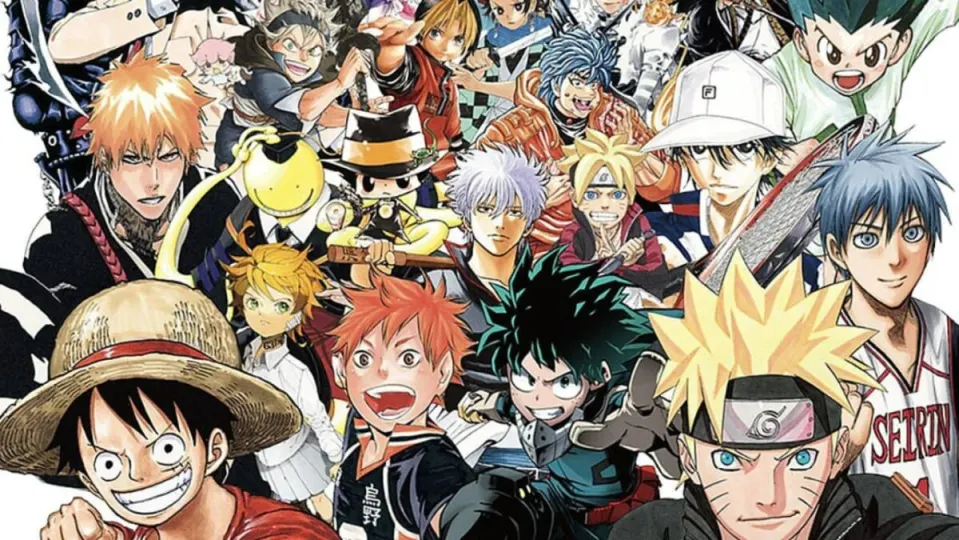Some say that the first manga is to be found in the scrolls of the twelfth century, but the truth is that it is generally agreed that the first Japanese comic as such has its origin two hundred years ago, with the publication of ‘Hokusai manga’, by Hokusai (the author of the famous wave of Kanagawa). It consisted of unconnected drawings that had no narrative, but it established the importance that visual iconography was to be given in Japan.
From then until now, millions of manga have been published and the otaku public is in a constant state of ferment: there are about 150 weekly or monthly magazines full of different series, which are then compiled in volumes, of which the most important ones usually reach us in Europe. We can talk all we want about Marvel, DC and independent comics, but what kids really read is here, among people with outstretched arms, high school sweethearts and people turned into chainsaws. Want to get started in the hobby? We’ve selected ten perfect manga to get you started. The bad news is that you’ll never want to quit.
One piece (Eiichiro Oda)
Volumes: 105 (and counting)

From its inception in 1997 until now, ‘One Piece‘ has become more than just the trendy shonen (for boys) manga: it is pure pop culture and one of the greatest adventures in the history of fiction. What started out as something very simple has become entangled with hundreds of characters whose lives, careers and fights are intertwined and you never know when they will become important again. Comedy, drama, fights and a lot of heart in the manga that, if you don’t feel lazy, you have to read. In Spain it is published in two different editions: one volume by volume and another one, which has just started, that joins three in one. As difficult to read as it is easy to collect.
Monster (Naoki Urasawa)
Volumes: 9
Naoki Urasawa’s work is counted by masterpieces more than by manga: ’20th century boys’, ‘Pluto’, ‘Asadora!’ and, of course, ‘Monster’, the first one that came to Spain and possibly the most remembered. A story full of folds, unexpected twists and an exquisite drawing that will surprise you. Also, in case you find it hard to read things set in Japan, you should know that almost all of its 162 episodes take place in Germany and the Czech Republic. Ah! You can find it in kanzenban (fat) volumes published by Planeta.
Adolf (Osamu Tezuka)
Volumes: 1, 2 or 5

Osamu Tezuka is considered the “god of manga” and it’s not an appellation given by chance. It’s practically impossible for you to read everything he wrote and drew during his lifetime, but there is one manga in particular that you should check out as a fabulous chronicle of Nazism: ‘Adolf’ was published in the mangaka’s mature stage, in 1982, and tells the story of three different Adolfs who will have parallel lives. Including, of course, Hitler. A real pearl that you can find in full volume format, in two large volumes or five more transportable ones. You choose, but read it anyway.
Maison Ikkoku (Rumiko Takahashi)
Volumes: 10

It’s hard to choose something from Rumiko Takahashi, the author of works like ‘Ranma 1/2’, ‘Inu Yasha’ or ‘Lamu’, but we’ll take one of her first titles, an adult romance manga with a lot of crazy comedy that will make you fall in love with each of the characters of that crazy house, but especially with Kyôko and Godai, who will live encounters, misunderstandings, continuous love and heartbreak until, probably, the most satisfying ending of an author who finds it hard to finish her stories. Just now it has just begun to be republished in ten large volumes, but if you are very old you may remember its first edition as ‘Juliette je t’aime’.
Video Girl Ai (Masakazu Katsura)
Volumes: 9 or 15

Maybe it’s because it’s the first manga I ever read, but I’ve always found a purity in ‘Video Girl Ai’ that I don’t see in other romantic shonen. Yes, it exaggerates the sexual attributes of its protagonists. Yes, it drags on a little bit. But it’s so dramatic, so adolescent, so hopelessly romantic, so racy and so funny that you just have to read it to realize what manga in the 90’s was all about in one work. If you like it, it goes together with another mythical work by Katsura, ‘I “s’. You can find it in a series of 15 volumes that came out a long time ago and included its sequel ‘Video Girl Len’ or in a reprint in 9 volumes that will begin soon by Planeta.
Good evening, Punpun (Inio Asano)
Volumes: 13

Inio Asano is one of the most interesting adult voices in manga. His are ‘Solanin’ or ‘Dead Dead Demons Dededede Destruction’: he is a specialist in, under a layer of sweetness and innocence, breaking your heart into a thousand pieces. And nowhere as in Punpun, the series about a dysfunctional character who grows from childhood to his twenties: the manga begins as the profile of a strange character in a world he doesn’t understand and ends up delving into philosophy and nihilism in an unforgettable and emotionally catastrophic final stretch. A marvel.
Uzumaki (Junji Ito)
Volumes: 1

When talking about influential authors in contemporary horror, Junji Ito has to appear. His convoluted images, languid stories, threadbare characters and devastating black and white make stories like ‘Uzumaki’ authentic windows to nightmares. In a single volume (or 6 if you have the old edition) you will see a people gradually becoming obsessed with spirals until, suddenly, they are the only thing that matters in their lives….. And you will enter a state of madness from which there is no return. If you like it, don’t miss the rest of his work, published extensively over the years (but especially the terrific ‘Tomie’. You’re welcome).
My Father’s Almanac (Jiro Taniguchi)
Volumes: 1

And the exact counterpoint to Ito is Jiro Taniguchi, an author focused on tranquility, landscapes, walks and melancholy who reached his masterpiece in ‘My Father’s Almanac’, a twist on nostalgia that reflects the transformation of Japan represented in a family, and in particular a father, who, like all people, is full of edges and is much more complex than he seems. If you want to delve into his work, ‘The Wayfarer’ and ‘Distant Neighborhood’ will fill you with joy and, at the same time, sadness. This is the magic of Taniguchi.
My Lesbian Experience with Loneliness (Kabi Nagata)
Volumes: 1

Kabi Nagata is a mangaka with mental problems who has depicted her life in several manga, the most famous of which is this one, in which she tells how she overcame her shyness to hire a lesbian prostitute… And the mistake it was. Nagata is direct, honest, funny and although she falls into self-hatred more times than we, as readers, would like to read, it is more than understandable seeing the life she tells us about. As you will probably want more after reading the volume edited by Fandogamia, you also have ‘Exchange diary (with myself)’, ‘I ended up in a rag running away from reality’ and ‘Kabi Nagata, wandering warrior’. They never reach the refreshing novelty of this volume but they are great all the same.
Yotsuba! (Kiyohiko Azuma)
Volumes: 15 (and counting)

Yotsuba is a girl who discovers the world. That’s the manga. That’s all there is to it. It’s the cutest and cutest thing you’ll ever read in your life, thanks to some kind and well-defined characters, a funny and adorable drawing, Azuma’s perfect understanding of the childish mind and the absolute love that is her protagonist. There is no choice but to end up loving it. Unlike many other series, each chapter of the manga is monthly, which prevents volumes coming out at full speed. Better: it’s a chance to take life easy. Just like Yotsuba.


